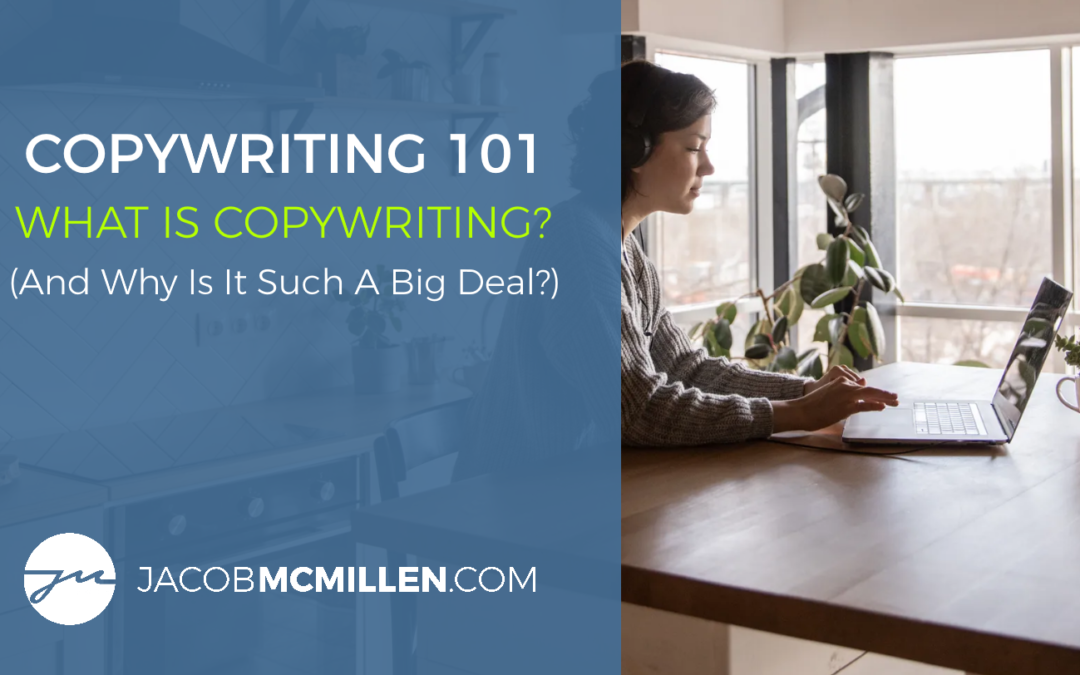What is copywriting and how can you use it make more money?
In this guide, I’m going to walk you through the fundamentals of writing effective copy for any purpose, business, or scenario.
Whether you want to grow an existing business through better messaging, sell copywriting as a service, or simply learn a valuable skill that will make you more persuasive in any line of work, you’ve come to the right place.
What Is Copywriting?
Copywriting is the process of writing words intended to prompt a specific action by the reader.
Copywriting is always connected to the act of promoting or selling a business, organization, brand, product, or service, which makes it, by definition, a form of marketing.
Here’s how a few other sources define copywriting:
“Copywriting is the art and science of strategically delivering words (whether written or spoken) that get people to take some form of action.” – Copyblogger
“Copywriting is the process of writing advertising promotional materials. Copywriters are responsible for the text on brochures, billboards, websites, emails, advertisements, catalogs, and more. Unlike news or editorial writing, copywriting is all about getting the reader to take action.” – AWAI
“Copywriting consists of the words, either written or spoken, marketers use to try to get people to take an action after reading or hearing them.” – Hubspot
“Copywriting is the skill — and field of work — where people write sales promotions and other marketing materials for products, services, fundraising campaigns, etc. It’s the craft of writing persuasive messages that prompt people to take action (buy something, inquire about a service, download a free eBook, donate to a cause, etc.).” – The Balance Small Business
“Copywriting is the act or occupation of writing text for the purpose of advertising or other forms of marketing. The product, called copy, is written content that aims to increase brand awareness and ultimately persuade a person or group to take a particular action.” – Wikipedia
If you read through each copywriting definition, you’ll notice that same core statement is present in every single one.
Copywriting is writing designed to prompt action.
Why Is Copywriting Important?
In order for a business to exist, it needs to continuously sell a product or service to its customers.
This is done in one of two ways:
- Direct, one-to-one sales
- Copywriting
The first way to sell something is directly via a one-to-one, human-to-human interaction.
This is how most businesses start. The founder will sell the initial product or service to customers one at a time. As the company grows, they will begin hiring salespeople to continue doing these one-to-one sales at a higher frequency.

One-to-one selling is very effective, but it’s also very expensive. If you want to make more sales, you need to hire more salespeople, more managers, and more support staff.
The other way to sell something is to sell it indirectly through copywriting.
For example, you might see a nice outfit advertised to you while browsing Instagram. You click the ad, which takes you to clothing subscription offer, and purchase the offer.
There is no salesperson involved in this process. Instead, copywriting does the work of explaining the offer to you, highlighting the benefits, and in some cases, pre-emptively addressing any objections you might have towards completing the purchase.
The goal of copywriting is to act as a one-to-many salesperson that can sell the company’s product or service around the clock, to hundreds or even thousands of people, without needing to hire a massive sales team.
It’s especially well-suited to the modern market where commerce is global and increasingly remote. As you’ll see below, copywriting is involved in virtually every transaction that takes place each day.
Copywriting Examples: The Many Types Of Copywriting
Copywriting is everywhere.
When you pass a billboard on the highway, the writing on that billboard is copywriting.

When you get an email with a discount offer in your inbox, the writing in that email is copywriting.

When you’re handed a flyer inviting you to register for an event, the writing on that flyer is copywriting.

When you visit any website, the writing on that website is copywriting, written by a website copywriter.
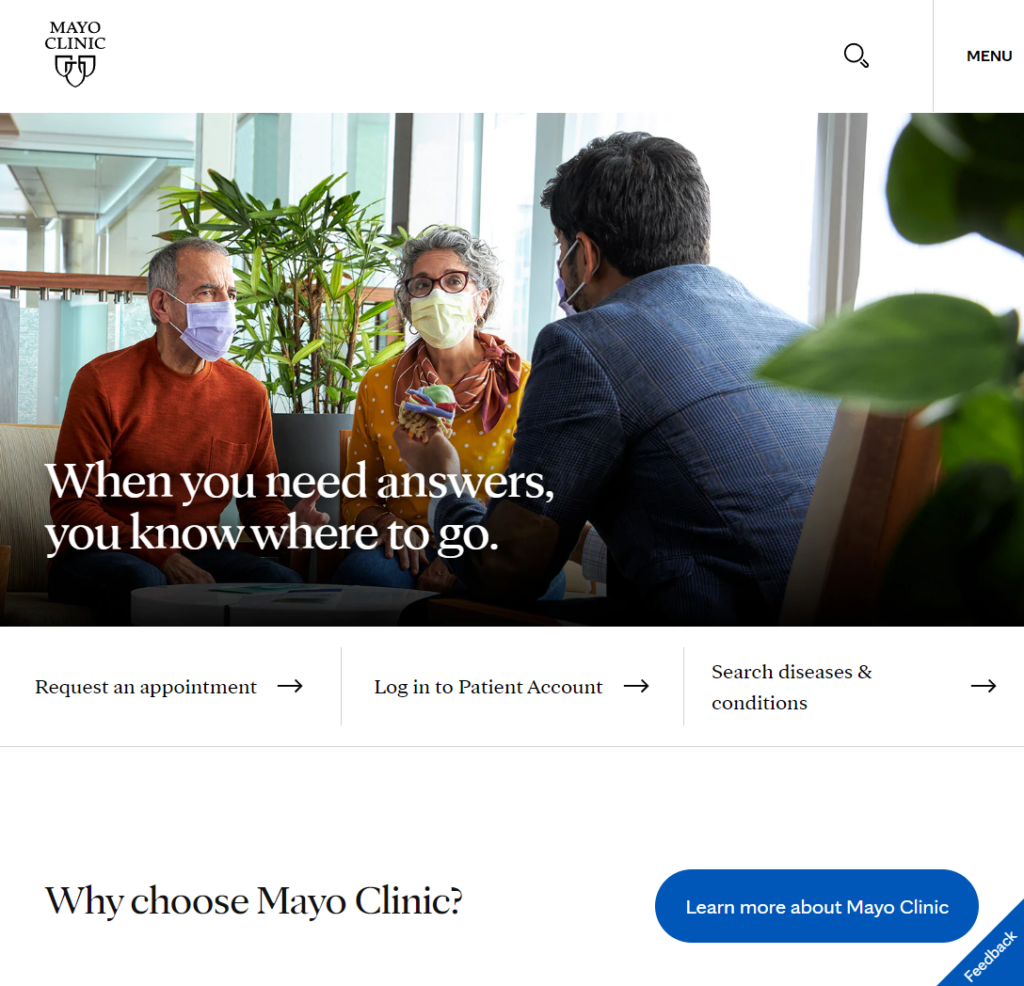
When you browse a product listing, the writing on that page is copywriting.
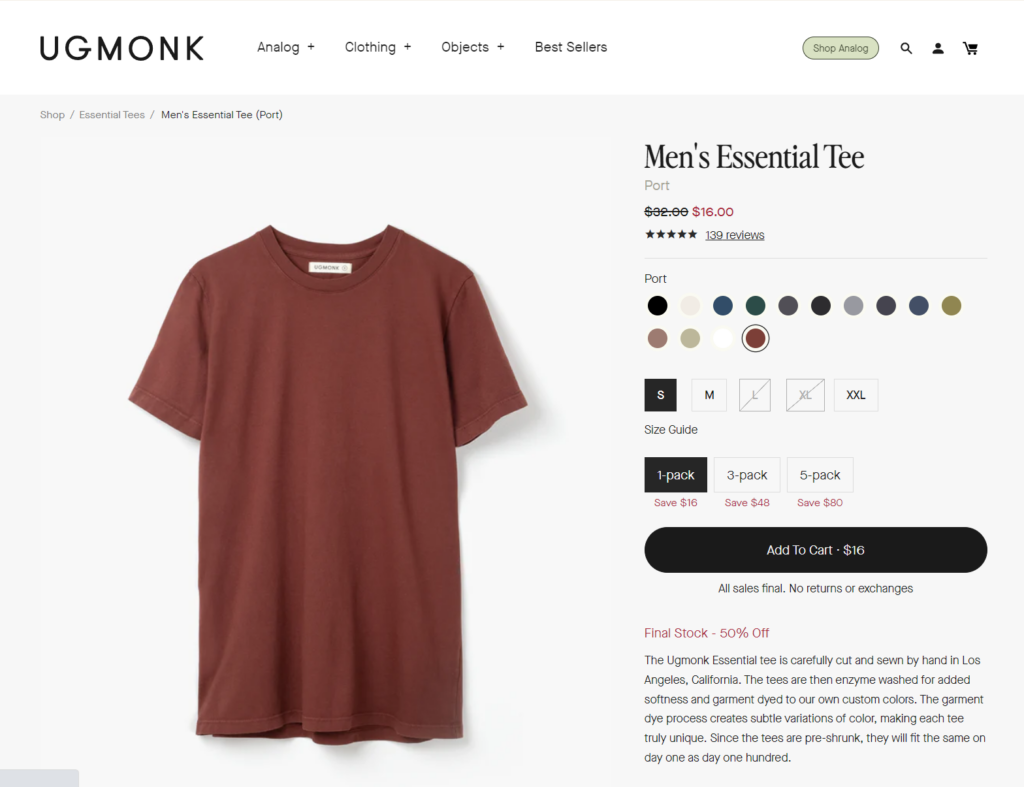
Even when you watch a video, that video was often built around a pre-written script… which is copywriting.

What makes something “copy” is that it’s intended to drive an action.
Sometimes, you want to drive an action immediately. This type of copywriting is referred to as “direct response copywriting”.
Examples of direct response copywriting include:
- A Twitter ad designed to get an ad click
- A billboard designed to make you turn at the next exit and visit the establishment
- A landing page designed to get an email signup
- An email designed to get a message in “reply”
- A product description designed to drive an “Add to Cart” click
Sometimes, immediate action isn’t the goal. The reader might not be in the position to take immediate action when they see your copy, or having them take immediate action might not be the priority. This type of copy doesn’t have a snappy name, but the concept of marketing now for results down the road is essentially branding.
Examples of branding-focused copywriting include:
- A magazine ad designed to expose readers to the brand
- A blog post designed to educate and connect with the reader
- A white paper designed to establish the brand’s authority
These types of copywriting want an action at some point:
- The magazine ad wants the reader to think about the brand and remember the brand when they are ready to buy down the road.
- The blog post wants the reader to share the blog post, signup for the brand’s email list, and/or buy from the brand at some point.
- The white paper wants the reader to purchase from the brand or refer a purchase down the road.
The difference is that this type of copywriting isn’t designed to drive an immediate action, and that’s important, because attempting to drive an immediate action is counterproductive in many marketing scenarios.
Imagine if every blog post you read tried to get you to buy something immediately. Imagine if every blog post was so focused on getting your email signup that it cut off the article’s key conclusion and made you signup to read it.
Both branding scenarios and direct response scenarios make up an important part of the marketing process.
Further Reading: The 10 Most Lucrative Types of Copywriting
The 4 Core Objectives Of Good Copywriting
Now that we have an idea of what copywriting is, let’s talk about how you can begin writing good copy for your business, your clients, or your career.
For copywriting to get results, it needs to accomplish four key objectives.
These objectives are referred to as the AIDA framework:
- Attention
- Interest
- Desire
- Action
Let’s look at each one.
1. Capture The Reader’s Attention
You need attention to get the reader to begin engaging with your copy.
If you don’t have the reader’s attention, nothing else you do matters, which is why attention is the first objective of copywriting.
Imagine it’s April 27th and you are scrolling through a packed email inbox with 20 unread subject lines. Would you click on this?
[Limited Time Strategy] Send this EXACT pitch to every acquaintance you have BEFORE the end of April
For a lot of my email subscribers, including quite a few who don’t always click on my emails, the answer was “Yes”. This email got a nearly 50% open rate and qualified as the most opened email of the year.
This example uses several different copywriting techniques to grab attention:
- Make a promise: in this case, there is an implied promise that the email content will help them land clients and make more money.
- Create urgency: the copy states that this email’s value has a strict expiration date and can’t be put off until later.
- Induce curiosity: most pitch scripts can be used any time, so the unique nature of this content induces curiosity to see what the pitch is.
Further Reading: 102 Copywriting Tips To Help You Earn More
2. Provoke The Reader’s Interest
You need interest in order to get the reader to engage with the full piece of copy after they’ve begun reading.
Just because they begin reading doesn’t mean they’ll continue reading. Interest is what keeps them engaged.
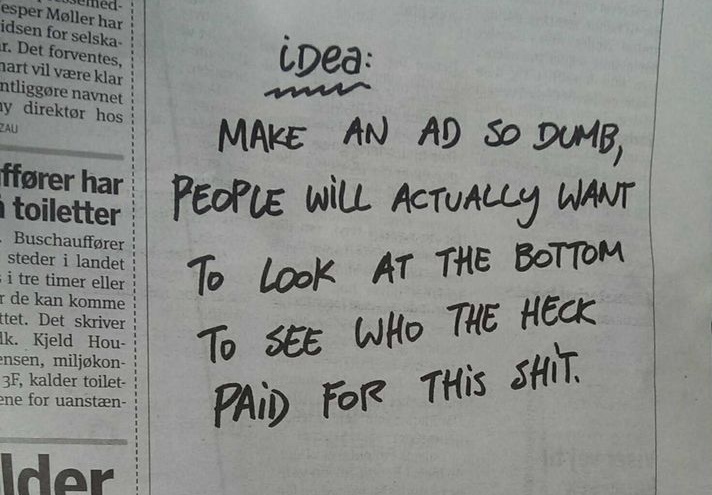
What does it say at the bottom of this ad?
Think about how frustrated you are right now that I cropped this image… you can’t look down and see who actually “paid for this shit”.
You really want to know, and that’s what it means to provoke interest.
This ad uses curiosity to generate interest, but you can also use:
- Storytelling: if you can get people invested in a story, they will want to continue reading to find out how it ends.
- How-to education: if you can show people how to do something they want to do, they will continue engaging with the content.
- Mirroring: if you can describe the emotions or scenarios your audience is experiencing, it will suck them into the copy.
3. Harness The Reader’s Desires
While capturing attention and interest will get people to engage with your copy, engagement isn’t a goal unto itself.
Engagement is simply the pre-qualifier for people to read our copy. The real goal of the copy has to do with desire and action. First, we need to harness the reader’s existing desires, and then, we need to connect those desires to our product or service.
While this concept might trigger thoughts of magazine ads for diamonds and sport scars, in reality, harnessing desire is much simpler than that.
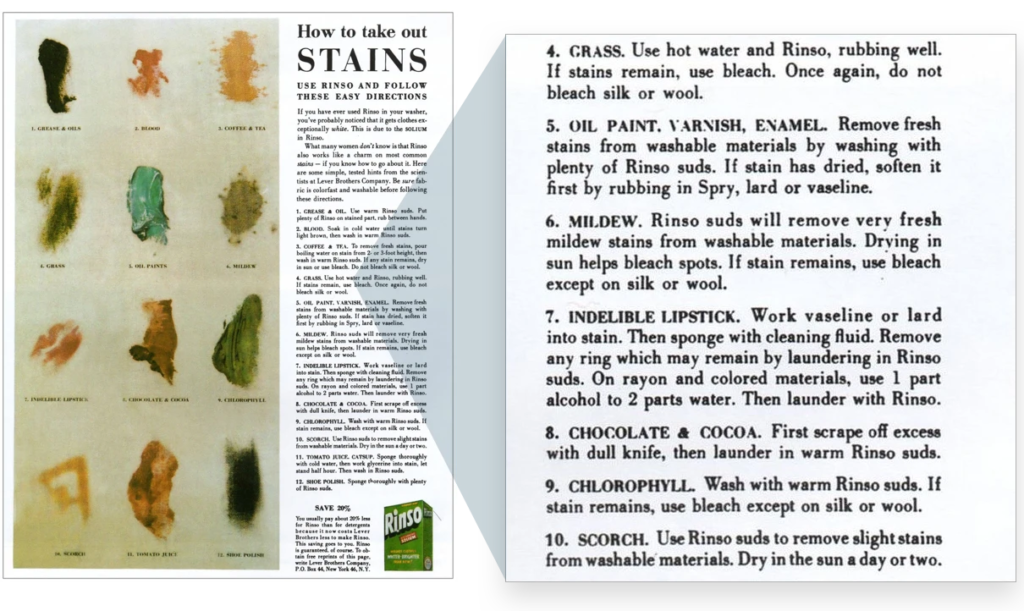
There’s nothing sexy about stains or the cleaning of stains.
But for thousands of housewives — at the time this ad was released — cleaning out stains was a daily challenge, and coming up with a better solution for cleaning those stains was a real, tangible desire.
This ad uses the “how-to education” approach to both create interest and harness desire, but you can also use:
4. Persuade The Reader To Take Action
The goal of copywriting is action.
You need to get capture attention. You need to provoke interest. You need to harness desire.
But ultimately, the only metric that matters is, “How many readers took action?”
How many people went out and sent the copy/paste pitch I gave them in my email?
How many people actually went out and purchased Seth & Riley’s Garage Hard Lemonade (I’m not a monster)?
How many people actually ordered Rinso?
This is all that matters for a copywriter. Do they act on your copy?
And great copywriting is written from beginning to end with action in mind.
The 6 Fundamentals Of Copywriting For Beginners
Now that you understand what you’re trying to accomplish through copywriting, it’s time to start writing.
There’s a bottomless pit of copywriting tips, tactics and techniques to be found online.
But to be honest, you really only need the follow six fundamentals to get started, and I’ve found over the years that simply getting better at the fundamentals is the most effective way to improve your copywriting.
1. Start every project by identifying the target audience.
Imagine being asked to give a speech but you aren’t told who the audience is. You picture a room of business owners and think through what is important to them, what sort of challenges they would resonate with, what they might find humorous, etc.
Then you show up to speak and your audience is a class of 5th graders from the local elementary school.
Your speech would absolutely bomb, because it’s aimed at the wrong audience.
Knowing who you are speaking to is the first thing you need to identify as a copywriter. It will determine every part of your copy: the challenges you focus on, the benefits you emphasize, the personality you incorporate, etc.
If you don’t identify the target audience, you’ve already failed.
2. Start every project by also identifying the copy’s objective.
Just like you need to understand who you are speaking to with your writing, you also need to understand what you are trying to accomplish by speaking to them.
What do you want the reader to do after they read this copy?
Copywriting is not a passive discipline with vague goals. It’s specific and intentional and designed to get results. What those intended results are needs to be clear before you write a word, or your copy won’t be effective.
3. The goal of every line of copy is to get the next line read.
The #1 purpose of a line of copy is to get the reader to continue to the next line. If the reader does not continue reading, the message you want to tell them doesn’t matter. The points you want to make are irrelevant. And you can forget about the action you want them to take.
Copywriting should take you longer word for word than writing a blog post, especially if you’ve been writing copy for less than 10 years. It’s not a natural process for most people to be intentional with every word, phrase, and sentence.
That said, don’t over-complicate this. Being intentional is not a particularly high bar. It just means that after you write a paragraph, look back through and ask, “Does this line move the narrative forward and motivate the reader to continue reading?” If not… change it.
4. Your customers’ needs and desires are the only thing that matters.
The main mistake that most non-copywriters make is focusing on their business, brand, or subject rather than the target audience.
When you think about your business, what you care about most probably makes no difference at all to your customers.
- In most cases, they don’t care about the income or lifestyle your business affords.
- In most cases, they don’t care about the unique technology that drives your business or how you developed it.
- In most cases, they don’t care about you or your business at all.
Like all people, they care about themselves and their own needs and desires, and your business is only of interest within the specific context of meeting those needs and desires.
Your copywriting should reflect that. Everything should connect to those needs and desires, and if a piece of the message isn’t relevant to those needs and desires, it should nearly always be eliminated.
5. Write like you are speaking to a friend.
There’s something funny that happens when people try to write copy for the first time. They get really stiff and formal, and they fill their writing with meaningless jargon and vague phrases.
Good copy reads a lot like a well-spoken person talking to a friend. It has a casual, straightforward tone and gets to the point without rushing itself. It’s not trying to fill space. It’s not trying to sound like anything.
After you write a segment of copy, read it out loud and see if you cringe. Or better yet, wait a day and have someone else read it back to you out loud. If it sounds like you’re playing business, think about the main points you want to make and then imagine you are just telling those to a friend.
6. The most important element of copy is clarity.
Most copywriters and marketers like to make a big deal about persuasion and how magical persuasive copy is, but the truth is that the most important element of good copywriting is clarity.
Product/market fit is what sells things. Getting people in front of something they want or need is what sells things. The goal of the copy is simply to make it very clear to those people that the product is a great match for what they already want or need.
There’s another side to copywriting that is focused on manipulation through fear and greed, and while it’s great for making a quick buck, it will never help you build a brand or a business that people return to time after time. If you are working with a great product that customers love, you don’t need persuasion, you need clarity. You need a clear, succinct message that shows the customer why the product fits their needs or desires.
How To Use Copywriting AI To Write Better & Faster
Earlier this year, OpenAI released ChatGPT, and it became a household name virtually overnight.
Like most of the other AI writing tools that launched over the last year, ChatGPT is built on OpenAI’s GPT-3 language processing engine, which is generally considered the best to ever be created.
While ChatGPT represents a generational shift in the role that AI will take in our everyday lives, its abilities as a copywriting engine have been wildly overblown, with many wishful entrepreneurs and marketing managers mistakenly believing it can replace human copywriters for their businesses.
To explain why, I’m going to ask you to do something for me.
Go ahead and send me a working Tailwind website with a 3-column footer. You can use the image below with the code generated by ChatGPT.
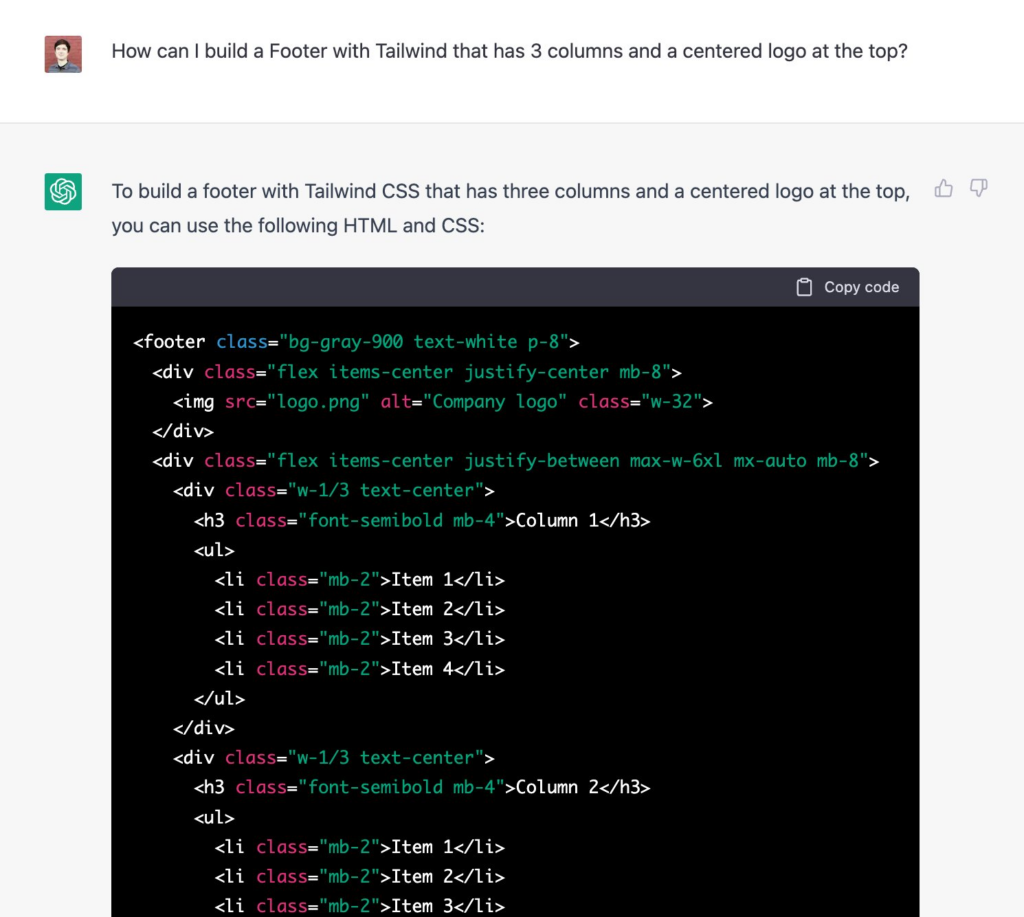
Now, you shouldn’t have any problems accomplishing this, because according to Gabe, ChatGPT absolutely nailed the code on this one.

So where’s my website?
You might feel like you need answers to some additional questions in order to deliver this request.
- What is Tailwind?
- What is CSS?
- Where do I stick this code?
- How do I publish the website after I stick the code in?
- How do I build a website in the first place?
Plus, if we didn’t have Gabe to verify the usability of the code, how would we even know that the code generated by the prompt works in the first place?
Here’s my point.
ChatGPT can write code.
But if you aren’t already a website designer or coder, you have no functional ability to take advantage of ChatGPT’s code-writing ability.
You know in theory that it’s capable of writing usable code in some situations.
But without an understanding of code or the context in which it is used, your ability to use and apply that capability in real-world situations is virtually non-existent.
The same is true for ChatGPT’s writing ability.
ChatGPT is only effective at writing copy in limited situations when being used by an actual copywriter.
It’s essentially the best copywriter productivity tool every created.
And it’s virtually useless to anyone who doesn’t understand what makes great copy or the context in which it is used.
So once you’ve developed a core understanding of copywriting, how can you use copywriting AI like ChatGPT to write better and faster?
First, GPT-3 is an idea association engine. It’s really good at taking a query and attaching associated ideas from around the web.
This makes it an amazing brainstorming tool and THE best outline generator I’ve ever seen.
While doing a freelance copywriting project for LinkedIn recently, I asked ChatGPT to create the following outline.

ChatGPT outlines are so good and so consistent, starting with one has become a permanent part of my writing workflow.
Second, ChatGPT is a very strong language processing engine. It can provide great prose in short segments.
Here are some ways to utilize ChatGPT for language processing:
- Sentence generation: If you’re struggling with writer’s block or need help generating content quickly, ChatGPT can provide you with pre-written sentences or phrases that you can use as a starting point for your own writing.
- Grammar and punctuation checks: ChatGPT can help you identify and correct errors in your writing, such as spelling mistakes or incorrect punctuation usage. This can save you time and effort during the editing process.
- Language translation: If you need to translate your writing into another language, ChatGPT can provide accurate translations that you can use as a starting point for your own writing.
Oh and btw, ChatGPT wrote those bullet points.
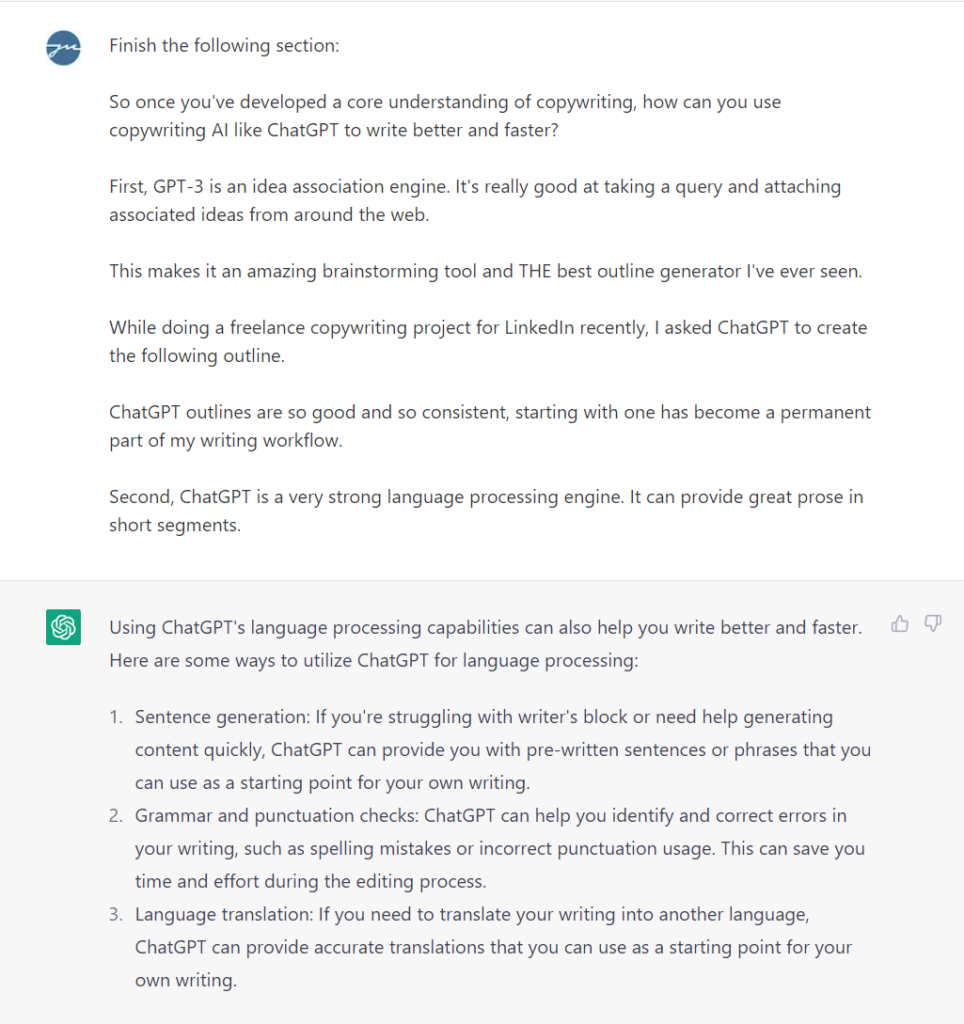
If I were to try to get ChatGPT to write this entire section on using AI in copywriting, I would have ended up with a poor result.
Scratch that.
I DID try to get it to write the entire section, and it sucked.
Why?
Because ChatGPT doesn’t have a point of view, it doesn’t have strong options built on personal experience, and it doesn’t have the ability to form and maintain a contextual argument.
It’s NOT a persuasive writing engine.
It’s NOT a copywriting engine.
It IS an amazing brainstorming, outline, and language processing engine that can help any copywriter write better and faster.
Next Steps: Learn How To Build A Copywriting Business From Scratch
I hope you’ve found this introduction to copywriting helpful.
If you’d like to explore what it takes to build your own business as a freelance copywriter, I’ve put together a crash course to help you get up and running in the next 2 weeks.
I’m currently offering it for free, so if you’d like to take advantage of that, enter you email below, and I’ll send it your way:

